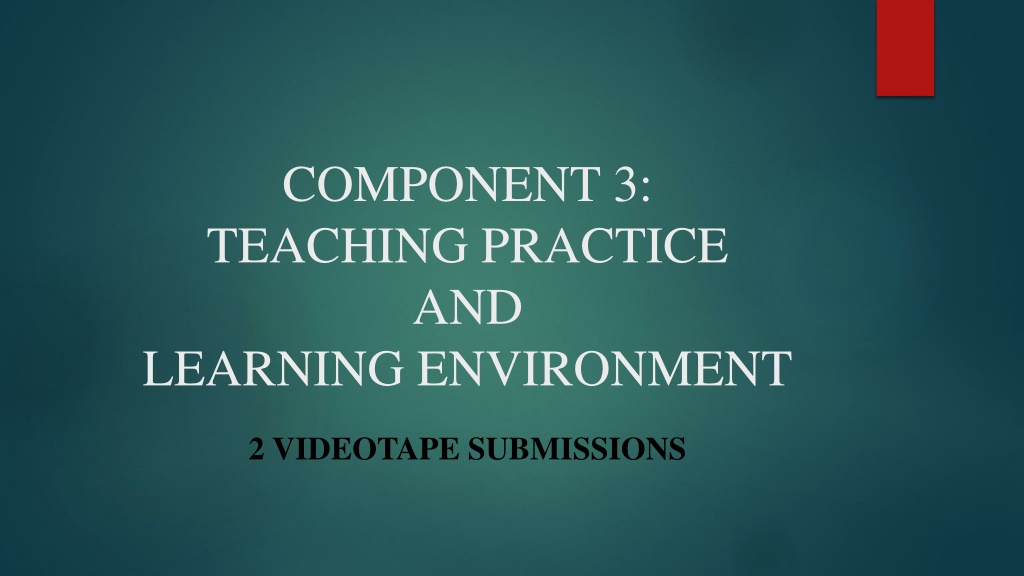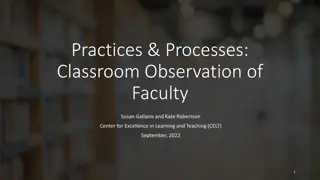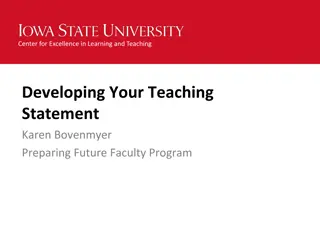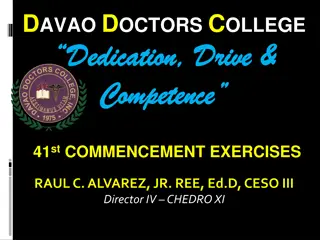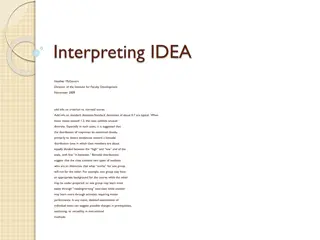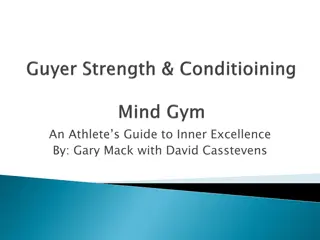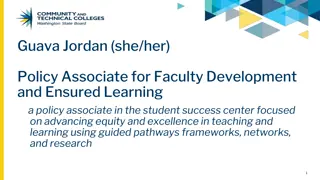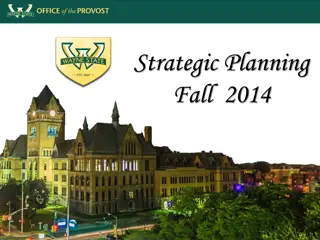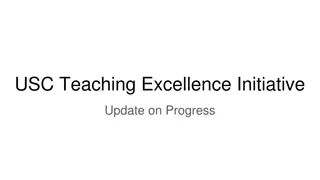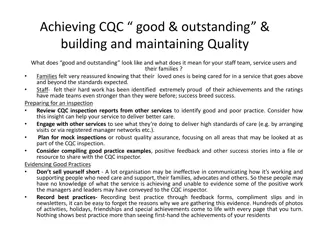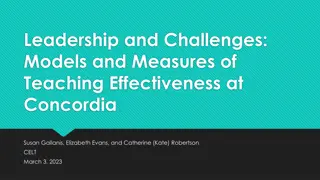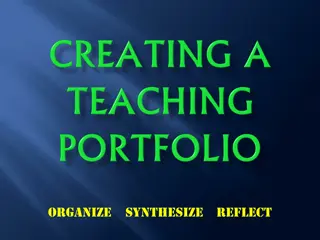Achieving Excellence in Teaching: A Comprehensive Guide
Explore the key components of teaching practice and learning environments through video submissions. Understand the Five Core Propositions for accomplished teachers, National Board Standards, and the Architecture of Accomplished Teaching. Learn about incorporating the standards into your teaching, different types of writing for the National Board, and an overview of Component 3 requirements for certification.
- Teaching practice
- Learning environment
- Five Core Propositions
- National Board Standards
- Accomplished teaching
Download Presentation

Please find below an Image/Link to download the presentation.
The content on the website is provided AS IS for your information and personal use only. It may not be sold, licensed, or shared on other websites without obtaining consent from the author. Download presentation by click this link. If you encounter any issues during the download, it is possible that the publisher has removed the file from their server.
E N D
Presentation Transcript
COMPONENT 3: TEACHING PRACTICE AND LEARNING ENVIRONMENT 2 VIDEOTAPE SUBMISSIONS
FIVE CORE PROPOSITIONS What accomplished teachers should know and be able to do Commitment to Students Knowledge of Subject Manage and Monitor Student Learning Think Systematically about Their Teaching and Learn from Experience Teachers are Members of Learning Communities
STANDARDS The Standards identify specific knowledge and skills that teachers should be able to do. National Board Standards are developed by committees of outstanding educators who are broadly representative of accomplished professionals in their field.
UNDERSTANDING the STANDARDS Read the Standards. Think about how you incorporate the Standards. Highlight the things you already do in one color, things you sometimes do in one color, and things you may not do or rarely do in another color. This will help you determine your strengths and weaknesses. Show clear, consistent, and convincing evidence that your teaching is based on the Standards.
Architecture of Accomplished Teaching Know your students Set high, worthwhile goals Implement instruction Evaluate student learning Reflect on the effectiveness of your lesson Set new, high, worthwhile goals The Architecture of Accomplished Teaching illustrates how the use of the Five Core Propositions and the standards result in student learning.
WRITING FOR NATIONAL BOARD Three types of writing Descriptive tell, explain, list, describe, what the easiest type of writing to do Analysis why, so what, how, in what ways, tell your rationale, explain why helps the assessor see the significance of the evidence you present Reflection (now what) look back, look ahead, predict, what s next, areas of improvement, key success, etc using the past to determine future action
OVERVIEW of COMPONENT 3 Overview of the component for your certificate area Requirements of the portfolio Standards measured by Component 3 Portfolio Instructions Scoring Rubric
OVERVIEW This portfolio entry captures details about your instructional planning, direct evidence of your practice from two video recordings and instructional materials, and your analysis of and reflection on your teaching as displayed in two video recordings. You will be evaluated on the demonstrated evidence of your practice and analysis as it relates to instruction, student engagement, and the learning environment. This portfolio entry and the rubric used to assess your submission are aligned with the Five Core Propositions and the certificate area Standards.
What Do I Need to Do? Identify two lessons from different instructional units. Capture video that shows evidence of teaching practice, the learning environment, and student engagement. Together the two lessons must demonstrate a breadth of content, different instructional formats, and different teaching strategies. Provide an overview of your entry, with your rationales for including the two videos.
SELECTING the CLASS Both videos may feature the same class or different classes. At least 51% of the students in your class must be within the stated age range for your certificate. The focus of the entry is on your practice and your ability to facilitate student learning, not on the level of student achievement.
SELECTING a LESSON Lesson selected must provide evidence of Learning Environment safe, fair, equitable, and challenging, promotes student engagement, student centered, equip students with skills that support collaboration Student Engagement active engagement of the students with the teacher and each other, opportunities for students to engage in self-centered learning and meaningful expression Instruction learning activities that are authentic and coherent, connected to learning goals
What Do I Need to Submit? Instructional Context (1 page per video) Videos two video recordings (10 15 minutes each) from 2 different instructional units Written Commentary (no more than 4 pages each) Introduction to the Entry Form (1 page)
What Do I Need to Submit? continued Instructional Planning and Materials for each video (no more than 6 pages total per file) Completed Instructional Planning Form (1 page) 2 page description of your instructional planning and instructional strategies, and rationales for your choice of goals, strategies, and materials One or more instructional materials (no more than 3 pages total)
WRITING about PLANNING Complete the Instructional Planning Form Write a description (2 double spaced pages) of your instructional planning and decision making for promoting student learning in the context of the lesson featured in the video. In your description, respond to the prompts in the Writing about Planning section.
SELECTING INSTRUCTIONAL MATERIALS Include instructional materials that will help the assessor understand the lesson in the video recording (handouts, excerpts from teacher guides, instructions to students, etc.) These materials may have been used before, during, or after the activity featured on the video. Be sure that the instructional materials are legible and refer to people and places in ways that preserve anonymity. Do not exceed the page limit.
WRITTEN COMMENTARY Respond to the questions in the section entitled What to Include in Your Written Commentary. Use double spaced 11- point Arial font. Do not use last names of students or adults. Submit no more than 4 double spaces pages of for each of the videos. Be specific, cite examples from the video.
WHAT the ASSESSORS EXPECT to SEE The goals match the instruction seen on the video. Multiple teaching strategies are shown. Teacher-to-student interaction occurs. Student-to-student interaction occurs. Fairness, equity, access, and respect for diversity are evident.
FORMS Introduction to Entry Form follow the directions on the form Instructional Context Sheet (1 per video) be specific, adhere to the page limit Instructional Planning Form (1 per video) follow the directions on the form, be specific
RUBRICS Use the rubrics as a guide to determine the level of evidence provided that the teacher Engages students Plans authentic learning activities Monitors and evaluates student learning Creates student centered learning environment based on mutual trust and respect Establishes a safe, fair, equitable and challenging environment
RUBRICS continued Supports all students in developing the dispositions and proficiencies necessary for comprehending concepts related to the subject matter Draws on the detailed knowledge of students and his or her knowledge of the specific content matter in order to select high, worthwhile and attainable goals Describes his or her practice, analyzes it fully, reflects on its implications for future teaching, and seeks ways to improve his or her practice
Before you tape: Make sure your students meet the age requirement for your certificate area. Use the National Board Student and Adult Release Forms to get permission to include students and adults in the video. Read pages 33 40 from the General Portfolio Instructions regarding videotaping. Read and reread the portfolio instructions before you get started make sure you understand the instructions.
CONTACT INFORMATION Carolyn Tillman, NBCT JSU World Class Teaching Program College of Lifelong Learning 601-566-3624 cspecial 45@yahoo.com
